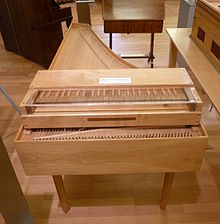Pantaleon (musical instrument)
The Pantaleon (also Pantalon ) is a historical large dulcimer that was invented by Pantaleon Hebenstreit (1668–1750) and named after him.
History and structure
The German musician Pantaleon Hebenstreit took his self-developed chopping board with him on a trip to France in 1705. When Johann Mattheson states: "King . Louis XIV . In Franckreich the instrument should getauffet, and have genennet Pantalon" From that point on was the instrument then only Pantal (e) on or at least (as in Telemann) pantalonisches cymbal .
A pantaleon was about four times the size of today's dulcimer. About 90 pairs of strings were stretched over each of the two soundboards , over one gut strings, over the other wire strings made of steel and brass. In depth, the instrument reached down to the Kontra-E. The pantaleon was struck with wooden mallets that were covered with leather on one side. Hebenstreit had these instruments built by Gottfried Silbermann . With these changes, the instrument was also suitable for art music, which explains its great popularity in the 18th century. Johann Kuhnau spoke in detail about the new invention (printed by Johann Mattheson, Critica musica , Vol. 2, Hamburg 1722).
Even Georg Philipp Telemann boasted Hebenstreit and his virtuosity in his autobiography, where he by his cooperation in Eisenach reports:
- Initially, the intention in Eisenach was only aimed at instrumental music, the members of which were the never enough praised Mr. Pantaleon Hebenstreit was looking for together, and whom I, as concertmaster, was put in front of him: consequently, at the table and in the chamber, I had to play the violin and the rest; since the latter took the name of director, but also played the last one, and could be heard on his admirable cymbal.
After the invention of the fortepiano or fortepiano , which was also inspired by Pantaleon Hebenstreit's dynamic playing style, his instrument, which was not easy to play, disappeared from musical practice.
The Pantaleon Clavier

The earliest square pianos in the second half of the 18th century were also called Pantaleon , as Pantaleon Hebenstreit was the model of the dynamic "hammer attack" with his instrument.
literature
- Margit Übellacker: Studies on the Pantaleon - Part I: Sources of the 17th and 18th centuries. In: Glareana. News from the Society of Friends of Old Musical Instruments. Vol. 57, issue 1, 2008, ISSN 1660-2730 , pp. 4-27, ( digital version (PDF; 9.84 MB) ).
- Margit Übellacker: Studies on the Pantaleon - Part II: On the double floor construction. In: Glareana. News from the Society of Friends of Old Musical Instruments. Vol. 57, Issue 2, 2008, ISSN 1660-2730 , pp. 44-66, ( digital version (PDF; 12.93 MB) ).
Web links
- Detailed text on the Pantaleone Hebenstreits in Das Hackbrett - Geschichte bis 1800. (English)
- Text on Pantaleon Hebenstreit with the Ensemble La Gioia Armonica